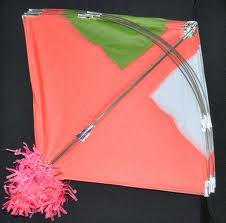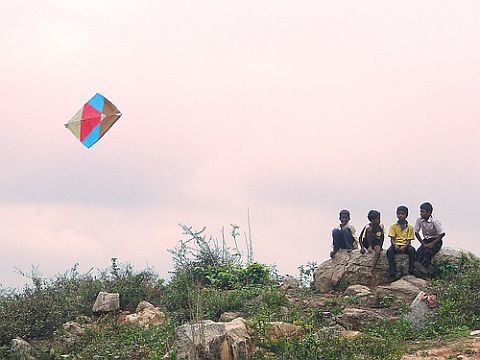- Home Page
- Kiddy Kites
- Fighter Kites
Fighter Kites
In the Hands of Young and Old
The basic idea of flying fighter kites is pretty much the same the world over. The last kite in the air wins, and this is usually achieved by cutting the flying lines of the other kites. Friction against other flying lines is used, not scissors!
 Photo courtesy of Modh Mahboob
Photo courtesy of Modh MahboobHowever, a pair of scissors did make an appearance during one highly irregular rokkaku battle. That was during a South Australian kite festival some years ago, here in Adelaide! So a little birdie told me.
Talking
about rokkakus, the traditional Japanese bouts just involved the downing
of kites by means other than sawing through the flying lines.
Most other fighter designs are actually unstable in the air while there is low tension in the flying line.
With the right
amount of extra tension applied, a skillful flyer can cause the kite to
dart off in any straight line direction desired. The rest of the time, the kite just lazily loops around and around, slowly losing height.
Flying fighters is not necessarily "kids stuff." However, huge numbers of kids in the countries with a kite-fighting culture do participate. The skills, in both construction and flying, have been passed down for generations.
On this site, there's more kite-making info than you can poke a stick at :-)
Want to know the most convenient way of using it all?
The Big MBK E-book Bundle is a collection of downloads—printable PDF files which provide step-by-step instructions for many kites large and small.
Every kite in every MBK series.
In addition to Japan's rokkaku, a number of other countries have one or more distinctive local fighter-kite designs. Here are several major examples, followed by the name of the traditional kite:
- India and Pakistan have the patang design. See the photo near the top of this page which shows several patangs stacked together, ready for sale. Other Indian-fighter designs exist, which are not so often flown by children.
- Afghanistan has the gudiparan design—or the Afghan fighter to most of us. These are made in a range of sizes, all much bigger than the Indian kites. I can't imagine the very biggest Afghan fighters being flown by children!
- Korea has the pangp'aeyon design, or shield kite. These have a distinctive large hole in the middle. There's much good info in this Korean kite blog, which refers to this type of kite as "bangpae."
- Brazil has the piao design. These are known as top kites, since the shape and traditional patterns make them look like spinning tops. Tails are used on these kites.
- Cuba has kites that are known as papalotes. Children fly fighters that are rather small six-sided designs that also use a tail for stability. No fighting kite is too stable though! That would make it an easy target.
Here is a picture of the five types; the order corresponds to the points above:
 Fighter kite designs from around the world
Fighter kite designs from around the world
Now, let's get back to those child flyers in all cultures... The kids
make fairly crude designs from whatever materials are available. Crude, that is,
in comparison to what can be bought from the local kite-makers.
Kite masters or designers and their assistants turn out extremely neat and well-balanced fighter kites for sale. Often these kites are exquisitely attractive to look at too! The smallest and cheapest of these are often flown by kids. Bamboo still dominates as a great traditional spar material, but the traditional sail materials of tissue and silk are starting to give way to more modern materials such as nylon, Mylar, and plastic.
As mentioned earlier, there's more kite-making on this site than you can poke a stick at :-)
Want to know the most convenient way of using it all?
The Big MBK E-book Bundle is a collection of downloads—printable PDF files which provide step-by-step instructions for many kites large and small.
Every kite in every MBK series.

